Developed during World War II by Lawrence Miles of General Electric, Value Analysis/Value Engineering (VA/VE) is a systematic process that supports production management. It allows Original Equipment Manufacturers (OEMs) to enhance a product's value by improving its performance or functionality while reducing costs. This article will shed light on the meaning of VA/VE in the context of the PCB assembly and outline the specific steps involved.
What is Value Engineering, and what is its purpose in electronics manufacturing?
Value Engineering is a strategic methodology that places a primary emphasis on the dynamic evaluation of a product's value and the associated manufacturing costs. This approach is vital in responding to the constantly shifting demands of the market, as it takes into account numerous external factors such as:
- Availability of alternative products;
- Competitor’s product evolution;
- Pricing dynamics;
- Customer expectations;
- Regulatory and compliance requirements;
- Other market trends.
Functionality and Cost Assessment in Value Engineering
The centre of VA/VE is the evaluation of a product's value, which is calculated as the ratio of its functionality to its overall cost. This ratio encapsulates diverse aspects of the product which define its capacity to fulfil its primary and secondary functions, including:
- Performance;
- Materials;
- Quality and reliability;
- Waste reduction;
- Environmental impact.
The total cost is based on the assessment of all expenses related to production, operation, and maintenance. Some of the core expenses are generated by:
- Research and development;
- Materials;
- Labour;
- Operations;
- Logistics and transportation;
- Waste and disposal;
- Quality assurance;
- Warranty and after-sales service;
- Overhead expenses;
- Regulatory compliance.
This analysis allows companies to identify and eliminate non-value-added activities, which generate costs but do not contribute to the product value. The results of the analysis become a foundation for a strategy aiming to enhance a product's value by optimising its functionality, reducing costs, or employing a combination of both approaches. The ultimate goal is to attain a product state where costs are minimised while the product's value is maximised.
Value Engineering and product’s lifecycle
Value Engineering is intricately woven into the entire product lifecycle. It can be applied not only during the manufacturing phase but also in the earlier stages, during the conceptualisation and design processes.
Additionally, Value Engineering principles are adaptable to quality and performance monitoring, enabling products to remain aligned with market changes, thereby ensuring ongoing optimisation to meet current demands.
Furthermore, Value Engineering continues to be invaluable in the later stages of a product's lifecycle, contributing significantly to overall cost management.
6 Steps Involved in the Value Engineering Process
Below is a detailed overview of the VA/VE process.
Step 1: Information gathering
Comprehensive information on every stage of the product's lifecycle is crucial for effective value engineering. The focus should be on its functionality and associated costs, encompassing all possible expenses, including production, quality control, testing, and logistics.
During this stage, the primary objective is to identify all elements contributing to the overall product cost, often referred to as the Cost of Goods Sold (COGS). The Pareto analysis is a popular methodology used for tracking finance allocation during this stage.
The outcome of the analysis should be a clear list of all cost components along with the percentage they contribute to the COGS. This data serves as a foundation for identifying the primary cost drivers. Their optimization may have the potential for cost reduction.
Step 2: Creative thinking
The next phase in the value engineering process is essentially an extensive brainstorming session to uncover potential ways to optimise both value and cost. Ideally, this session should be conducted by an interdisciplinary team. During this creative process, both experience and innovation play crucial roles, as any idea can potentially contribute to the optimisation of the product.
A fundamental aspect of this step is function analysis, which should concentrate on the functions of the elements generating costs, rather than the operational aspects of the device.
Based on this analysis, VA/VE teams can explore the possibilities of reimagining the product for optimization changes, for example:
- Material substitution;
- Functional redesign;
- Production or packaging optimization;
- Supply chain improvements;
- Eco-friendly solutions;
- Customization options.
Step 3: Evaluation
Before the OEM proceeds with practical implementation, it is essential to conduct a thorough evaluation of each idea for optimisation. One efficient way to achieve this is by creating a list of the advantages and disadvantages of each option and performing a weighted matrix analysis.
This step helps to determine which ideas appear more feasible, what their best alternatives are, and when the disadvantages outweigh the advantages.
Step 4: Development
The top-ranked ideas should undergo a more detailed assessment, with a focus on Return on Investment (ROI) calculations for the introduction of selected changes. This step ensures that the proposed change has strong potential for cost savings and offers the possibility of a relatively fast return on investment.
Step 5: Presentation
A carefully documented analysis of the most promising ideas proposed by the VA/VE teams should be presented to key stakeholders for approval. The team should include multiple options supported by meaningful data in the report. Additionally, the presentation should outline the project's timescale.
Step 6: Implementation
The value engineering process concludes with the implementation of the chosen option. The team is responsible for realising the plan depending on the area in which the change will be applied. While working with an electronics manufacturing service (EMS) provider, an OEM can get assistance not only in the modification of manufacturing processes but also in procurement, prototyping, and New Product Introduction (NPI).
Conclusion: Successful value engineering in PCB assembly
Value engineering allows original manufacturers of electronic devices, which are among the fastest-evolving products on today's market, to adapt production to industry shifts, remove non-value-added elements, and enhance competitiveness. These objectives are attainable through collaboration with competent experts from diverse disciplines throughout the product's lifecycle. This extends to the manufacturing process and quality control, where OEMs can leverage the expertise of EMS providers.






